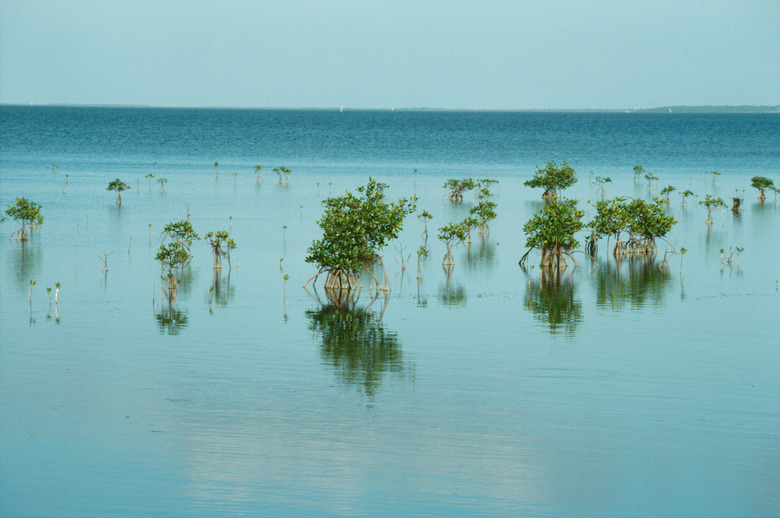Types Of Saltwater Ecosystems
A variety of saltwater ecosystems make up the ocean – the largest aquatic system on the planet – which covers over 70 percent of the Earth's surface. Saltwater ecosystems, also known as marine ecosystems, provide food, transportation, ecotourism opportunities and other important economic resources for humans around the globe.
Marine ecosystems not only house economically important species of ocean animals and plants but also provide saltwater habitat for their offspring. Saltwater ecosystems have come under stress in recent decades as the world's population increases and the condition of the environment diminishes.
Marine Wetlands: Marshes and Mangroves
Marine Wetlands: Marshes and Mangroves
Marine wetlands are transitional areas between the open ocean and coastal lands. Many organisms that live in marine wetland habitats spend part of their life in the intertidal zone and must adapt to a cycle of changing water levels and salinity. Examples of marine wetland ecosystems include mangroves and salt marshes.
Mangrove trees provide a perfect example of a species adapted to the dynamic wetland ecosystem, as they are one of the few types of trees that can survive in saltwater ecosystems.
Mangrove trees are essential to coastal marine ecosystems. Mangroves provide habitat for numerous organisms; harbor nesting sites and foraging grounds for birds, reptiles and mammals; buffer storms by functioning as wind breaks and baffling wave action with their roots; and filter water by catching sediment and detritus in their roots.
Salt marshes occur in protected areas along the coastline and provide many of the same benefits as mangrove habitats. Salt marshes typically occur in coastal regions in temperate and even arctic climates, whereas mangrove swamps occur in tropical and subtropical coastal regions. Instead of mangrove trees, herbaceous plants and grasses dominate salt marshes.
Brackish Estuaries
Brackish Estuaries
Estuaries are another important marine ecosystem where saltwater and freshwater meet to make a brackish mix. Estuaries provide habitat for over 75 percent of the United States' commercial fishing haul including crabs, clams, oysters, shrimp and other fish species. Because of their protected nature, estuaries provide important nesting grounds and habitat for juvenile aquatic plants and animals.
Estuary vegetation helps to filter runoff and other pollutants. However, since most water drains from the land to the ocean via estuaries, potential for pollution is high. Pollution diminishes estuary ecosystems and impacts the humans who depend on estuaries for food.
Biodiverse Coral Reefs
Biodiverse Coral Reefs
Coral reefs are among the world's richest ecosystems, second only to tropical rain forests in plant and animal diversity. Tropical coral reefs occur in shallow, warm waters, typically off the coast of a land mass or in areas where islands once existed. Corals reefs are fragile ecosystems that are sensitive to imbalances in water quality.
Coral reef food webs begin with algae, which are the primary source of energy in the reef. Corals and other filter feeders depend on phytoplankton – a form of algae – and detritus. Larger coral reef species rely on corals as a source of food and for protection, and coral reefs provide a protected nursery and hatchery area for many important fish species.
The Open Ocean
The Open Ocean
The open ocean – referred to as the pelagic zone – is the largest marine ecosystem. The further the ocean stretches from the coast, the more its depth increases. Deep, open ocean ecosystems receive fewer nutrients, less light and are colder than coastal habitats. Biomass decreases and currents increase as ocean depths increase.
The open ocean is home to microscopic floating plankton and also supports large sea mammals and bony fish. Animals that live in the open ocean tend to have streamlined bodies, specialized buoyancy features for long-distance swimming and sonar or good eyesight for hunting in dark water. Large fish of the pelagic zone are an important food resource for humans and include tuna, swordfish and sharks.
Cite This Article
MLA
King, Jennifer. "Types Of Saltwater Ecosystems" sciencing.com, https://www.sciencing.com/types-saltwater-ecosystems-6385556/. 30 September 2021.
APA
King, Jennifer. (2021, September 30). Types Of Saltwater Ecosystems. sciencing.com. Retrieved from https://www.sciencing.com/types-saltwater-ecosystems-6385556/
Chicago
King, Jennifer. Types Of Saltwater Ecosystems last modified August 30, 2022. https://www.sciencing.com/types-saltwater-ecosystems-6385556/
